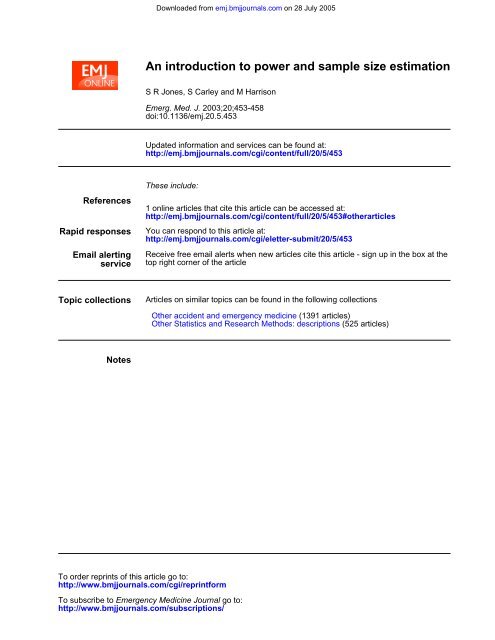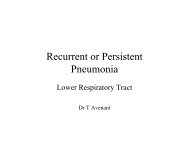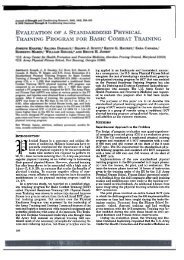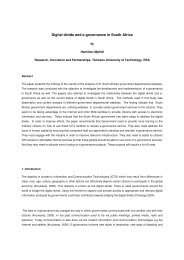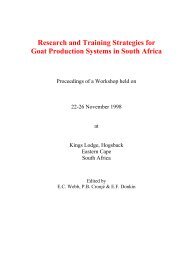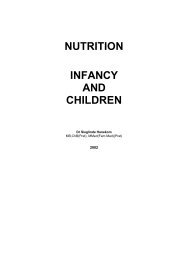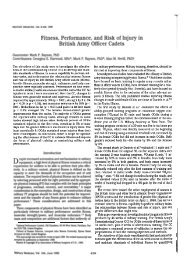An introduction to power and sample size estimation
An introduction to power and sample size estimation
An introduction to power and sample size estimation
You also want an ePaper? Increase the reach of your titles
YUMPU automatically turns print PDFs into web optimized ePapers that Google loves.
References<br />
Rapid responses<br />
Email alerting<br />
service<br />
Topic collections<br />
Notes<br />
<strong>An</strong> <strong>introduction</strong> <strong>to</strong> <strong>power</strong> <strong>and</strong> <strong>sample</strong> <strong>size</strong> <strong>estimation</strong><br />
S R Jones, S Carley <strong>and</strong> M Harrison<br />
Emerg. Med. J. 2003;20;453-458<br />
doi:10.1136/emj.20.5.453<br />
Updated information <strong>and</strong> services can be found at:<br />
http://emj.bmjjournals.com/cgi/content/full/20/5/453<br />
These include:<br />
To order reprints of this article go <strong>to</strong>:<br />
http://www.bmjjournals.com/cgi/reprintform<br />
1 online articles that cite this article can be accessed at:<br />
http://emj.bmjjournals.com/cgi/content/full/20/5/453#otherarticles<br />
You can respond <strong>to</strong> this article at:<br />
http://emj.bmjjournals.com/cgi/eletter-submit/20/5/453<br />
Receive free email alerts when new articles cite this article - sign up in the box at the<br />
<strong>to</strong>p right corner of the article<br />
Articles on similar <strong>to</strong>pics can be found in the following collections<br />
• Other accident <strong>and</strong> emergency medicine (1391 articles)<br />
• Other Statistics <strong>and</strong> Research Methods: descriptions (525 articles)<br />
To subscribe <strong>to</strong> Emergency Medicine Journal go <strong>to</strong>:<br />
http://www.bmjjournals.com/subscriptions/<br />
Downloaded from<br />
emj.bmjjournals.com on 28 July 2005
STATISTICS<br />
<strong>An</strong> <strong>introduction</strong> <strong>to</strong> <strong>power</strong> <strong>and</strong> <strong>sample</strong> <strong>size</strong> <strong>estimation</strong><br />
S R Jones, S Carley, M Harrison<br />
.............................................................................................................................<br />
The importance of <strong>power</strong> <strong>and</strong> <strong>sample</strong> <strong>size</strong> <strong>estimation</strong> for<br />
study design <strong>and</strong> analysis.<br />
..........................................................................<br />
See end of article for<br />
authors’ affiliations<br />
.......................<br />
Correspondence <strong>to</strong>:<br />
Dr S R Jones, Emergency<br />
Department, Manchester<br />
Royal Infirmary, Oxford<br />
Road, Manchester<br />
M13 9WL, UK;<br />
steve.r.jones@bigfoot.com<br />
Downloaded from<br />
emj.bmjjournals.com on 28 July 2005<br />
OBJECTIVES<br />
1 Underst<strong>and</strong> <strong>power</strong> <strong>and</strong> <strong>sample</strong> <strong>size</strong> <strong>estimation</strong>.<br />
2 Underst<strong>and</strong> why <strong>power</strong> is an important part of<br />
both study design <strong>and</strong> analysis.<br />
3 Underst<strong>and</strong> the differences between <strong>sample</strong> <strong>size</strong><br />
calculations in comparative <strong>and</strong> diagnostic studies.<br />
4 Learn how <strong>to</strong> perform a <strong>sample</strong> <strong>size</strong> calculation.<br />
– (a) For continuous data<br />
– (b) For non-continuous data<br />
– (c) For diagnostic tests<br />
POWER AND SAMPLE SIZE ESTIMATION<br />
Power <strong>and</strong> <strong>sample</strong> <strong>size</strong> <strong>estimation</strong>s are measures<br />
of how many patients are needed in a study.<br />
Nearly all clinical studies entail studying a <strong>sample</strong><br />
of patients with a particular characteristic rather<br />
than the whole population. We then use this <strong>sample</strong><br />
<strong>to</strong> draw inferences about the whole population.<br />
In previous articles in the series on statistics<br />
published in this journal, statistical inference has<br />
been used <strong>to</strong> determine if the results found are<br />
true or possibly due <strong>to</strong> chance alone. Clearly we<br />
can reduce the possibility of our results coming<br />
from chance by eliminating bias in the study<br />
design using techniques such as r<strong>and</strong>omisation,<br />
blinding, etc. However, another fac<strong>to</strong>r influences<br />
the possibility that our results may be incorrect,<br />
the number of patients studied. Intuitively we<br />
assume that the greater the proportion of the<br />
whole population studied, the closer we will get <strong>to</strong><br />
true answer for that population. But how many do<br />
we need <strong>to</strong> study in order <strong>to</strong> get as close as we<br />
need <strong>to</strong> the right answer?<br />
WHAT IS POWER AND WHY DOES IT<br />
MATTER<br />
Power <strong>and</strong> <strong>sample</strong> <strong>size</strong> <strong>estimation</strong>s are used by<br />
researchers <strong>to</strong> determine how many subjects are<br />
Table 1 Two by two table<br />
Emerg Med J 2003;20:453–458<br />
needed <strong>to</strong> answer the research question (or null<br />
hypothesis).<br />
<strong>An</strong> example is the case of thrombolysis in acute<br />
myocardial infarction (AMI). For many years clinicians<br />
felt that this treatment would be of<br />
benefit given the proposed aetiology of AMI,<br />
however successive studies failed <strong>to</strong> prove the<br />
case. It was not until the completion of adequately<br />
<strong>power</strong>ed “mega-trials” that the small<br />
but important benefit of thrombolysis was<br />
proved.<br />
Generally these trials compared thrombolysis<br />
with placebo <strong>and</strong> often had a primary outcome<br />
measure of mortality at a certain number of days.<br />
The basic hypothesis for the studies may have<br />
compared, for example, the day 21 mortality of<br />
thrombolysis compared with placebo. There are<br />
two hypotheses then that we need <strong>to</strong> consider:<br />
1 The null hypothesis is that there is no difference<br />
between the treatments in terms of mortality.<br />
2 The alternative hypothesis is that there is a difference<br />
between the treatments in terms of mortality.<br />
In trying <strong>to</strong> determine whether the two groups<br />
are the same (accepting the null hypothesis) or<br />
they are different (accepting the alternative<br />
hypothesis) we can potentially make two kinds of<br />
error. These are called a type Ι error <strong>and</strong> a type ΙΙ<br />
error.<br />
A type Ι error is said <strong>to</strong> have occurred when we<br />
reject the null hypothesis incorrectly (that is, it is<br />
true <strong>and</strong> there is no difference between the two<br />
groups) <strong>and</strong> report a difference between the two<br />
groups being studied.<br />
A type ΙΙ error is said <strong>to</strong> occur when we accept<br />
the null hypothesis incorrectly (that is, it is false<br />
<strong>and</strong> there is a difference between the two groups<br />
which is the alternative hypothesis) <strong>and</strong> report<br />
that there is no difference between the two<br />
groups.<br />
They can be expressed as a two by two table<br />
(table 1).<br />
Power calculations tell us how many patients<br />
are required in order <strong>to</strong> avoid a type Ι or a type ΙΙ<br />
error.<br />
Actual truth<br />
Treatment<br />
benefit<br />
No treatment<br />
benefit<br />
Clinical trial result Treatment benefit Correct result Type Ι error<br />
False positive result<br />
No treatment benefit Type ΙΙ error Correct result<br />
False negative result<br />
453<br />
www.emjonline.com
454 Jones, Carley, Harrison<br />
The term <strong>power</strong> is commonly used with reference <strong>to</strong> all<br />
<strong>sample</strong> <strong>size</strong> <strong>estimation</strong>s in research. Strictly speaking “<strong>power</strong>”<br />
refers <strong>to</strong> the number of patients required <strong>to</strong> avoid a type ΙΙ<br />
error in a comparative study. Sample <strong>size</strong> <strong>estimation</strong> is a more<br />
encompassing term that looks at more than just the type ΙΙ<br />
error <strong>and</strong> is applicable <strong>to</strong> all types of studies. In common parlance<br />
the terms are used interchangeably.<br />
WHAT AFFECTS THE POWER OF A STUDY?<br />
There are several fac<strong>to</strong>rs that can affect the <strong>power</strong> of a study.<br />
These should be considered early on in the development of a<br />
study. Some of the fac<strong>to</strong>rs we have control over, others we do<br />
not.<br />
The precision <strong>and</strong> variance of measurements within<br />
any <strong>sample</strong><br />
Why might a study not find a difference if there truly is one?<br />
For any given result from a <strong>sample</strong> of patients we can only<br />
determine a probability distribution around that value that<br />
will suggest where the true population value lies. The best<br />
known example of this would be 95% confidence intervals.<br />
The <strong>size</strong> of the confidence interval is inversely proportional <strong>to</strong><br />
the number of subjects studied. So the more people we study<br />
the more precise we can be about where the true population<br />
value lies.<br />
Figure 1 shows that for a single measurement, the more<br />
subjects studied the narrower the probability distribution<br />
www.emjonline.com<br />
Downloaded from<br />
emj.bmjjournals.com on 28 July 2005<br />
Figure 1 Change in confidence<br />
interval width with increasing<br />
numbers of subjects.<br />
becomes. In group 1 the mean is 5 with wide confidence intervals<br />
(3–7). By doubling the number of patients studied (but in<br />
our example keeping the values the same) the confidence<br />
intervals have narrowed (3.5–6.5) giving a more precise<br />
estimate of the true population mean.<br />
The probability distribution of where the true value lies is<br />
an integral part of most statistical tests for comparisons<br />
between groups (for example, t tests). A study with a small<br />
<strong>sample</strong> <strong>size</strong> will have large confidence intervals <strong>and</strong> will only<br />
show up as statistically abnormal if there is a large difference<br />
between the two groups. Figure 2 demonstrates how increasing<br />
the number of subjects can give a more precise estimate of<br />
differences.<br />
The magnitude of a clinically significant difference<br />
If we are trying <strong>to</strong> detect very small differences between treatments,<br />
very precise estimates of the true population value are<br />
required. This is because we need <strong>to</strong> find the true population<br />
value very precisely for each treatment group. Conversely, if we<br />
find, or are looking for, a large difference a fairly wide<br />
probability distribution may be acceptable.<br />
In other words if we are looking for a big difference between<br />
treatments we might be able <strong>to</strong> accept a wide probability distribution,<br />
if we want <strong>to</strong> detect a small difference we will need<br />
great precision <strong>and</strong> small probability distributions. As the<br />
width of probability distributions is largely determined by<br />
how many subjects we study it is clear that the difference<br />
sought affects <strong>sample</strong> <strong>size</strong> calculations.<br />
Figure 2 Effect of confidence<br />
interval reduction <strong>to</strong> demonstrate a<br />
true difference in means. This<br />
example shows that the initial<br />
comparison between groups 1 <strong>and</strong> 3<br />
showed no statistical difference as the<br />
confidence intervals overlapped. In<br />
groups 3 <strong>and</strong> 4 the number of<br />
patients is doubled (although the<br />
mean remains the same). We see that<br />
the confidence intervals no longer<br />
overlap indicating that the difference<br />
in means is unlikely <strong>to</strong> have occurred<br />
by chance.
Fac<strong>to</strong>rs affecting a <strong>power</strong> calculation<br />
• The precision <strong>and</strong> variance of measurements within any<br />
<strong>sample</strong><br />
• Magnitude of a clinically significant difference<br />
• How certain we want <strong>to</strong> be <strong>to</strong> avoid type 1 error<br />
• The type of statistical test we are performing<br />
When comparing two or more <strong>sample</strong>s we usually have<br />
little control over the <strong>size</strong> of the effect. However, we need <strong>to</strong><br />
make sure that the difference is worth detecting. For example,<br />
it may be possible <strong>to</strong> design a study that would demonstrate a<br />
reduction in the onset time of local anaesthesia from 60<br />
seconds <strong>to</strong> 59 seconds, but such a small difference would be of<br />
no clinical importance. Conversely a study demonstrating a<br />
difference of 60 seconds <strong>to</strong> 10 minutes clearly would. Stating<br />
what the “clinically important difference” is a key component<br />
of a <strong>sample</strong> <strong>size</strong> calculation.<br />
How important is a type Ι or type ΙΙ error for the study<br />
in question?<br />
We can specify how concerned we would be <strong>to</strong> avoid a type Ι or<br />
type ΙΙ error. A type Ι error is said <strong>to</strong> have occurred when we<br />
reject the null hypothesis incorrectly. Conventionally we<br />
choose a probability of
456 Jones, Carley, Harrison<br />
Table 2 Egbert writes down some things that he thinks are important for the calculation<br />
What is the null hypothesis? That Jabba Juice will be no more effective than bendrofluazide in treating<br />
new presentations of hypertension.<br />
What level do we want <strong>to</strong> avoid a type Ι error at? (pα) We set this <strong>to</strong> 0.05<br />
What level do we want <strong>to</strong> avoid a type ΙΙ error at? (pβ) We set this <strong>to</strong> 0.8<br />
What is the “clinically important difference” we want <strong>to</strong> detect? For this study we want <strong>to</strong> detect a minimum 10 mm Hg difference between<br />
treatments.<br />
What type of data <strong>and</strong> analysis are likely? Continuous normally distributed data. To be analysed using a t test<br />
What is the st<strong>and</strong>ard deviation of blood pressure in this group of patients? From other studies we know that the st<strong>and</strong>ard deviation is 20 mm Hg.<br />
A key requirement is the “clinically important difference”<br />
we want <strong>to</strong> detect between the treatment groups. As discussed<br />
above this needs <strong>to</strong> be a difference that is clinically important<br />
as, if it is very small, it may not be worth knowing about.<br />
<strong>An</strong>other figure that we require <strong>to</strong> know is the st<strong>and</strong>ard<br />
deviation of the variable within the study population. Blood<br />
pressure measurements are a form of normally distributed<br />
continuous data <strong>and</strong> as such will have st<strong>and</strong>ard deviation,<br />
which Egbert has found from other studies looking at similar<br />
groups of people.<br />
Once we know these last two figures we can work out the<br />
st<strong>and</strong>ardised difference <strong>and</strong> then use a table <strong>to</strong> give us an idea<br />
of the number of patients required.<br />
The difference between the means is the clinically<br />
important difference—that is, it represents the difference<br />
between the mean blood pressure of the bendrofluazide group<br />
<strong>and</strong> the mean blood pressure of the new treatment group.<br />
From Egbert’s scribblings:<br />
Using table 3 we can see that with a st<strong>and</strong>ardised difference<br />
of 0.5 <strong>and</strong> a <strong>power</strong> level (pβ) of 0.8 the number of patients<br />
required is 64. This table is for a one tailed hypothesis, (?) the<br />
null hypothesis requires the study <strong>to</strong> be <strong>power</strong>ful enough <strong>to</strong><br />
detect either treatment being better or worse than the other, so<br />
Table 3 How <strong>power</strong> changes with st<strong>and</strong>ardised<br />
difference<br />
Sdiff<br />
Power level (pβ)<br />
0.99 0.95 0.90 0.80<br />
0.10 3676 2600 2103 1571<br />
0.20 920 651 527 394<br />
0.30 410 290 235 176<br />
0.40 231 164 133 100<br />
0.50 148 105 86 64<br />
0.60 104 74 60 45<br />
0.70 76 54 44 33<br />
0.80 59 42 34 26<br />
0.90 47 34 27 21<br />
1.00 38 27 22 17<br />
1.10 32 23 19 14<br />
1.20 27 20 16 12<br />
1.30 23 17 14 11<br />
1.40 20 15 12 9<br />
1.50 18 13 11 8<br />
Sdiff, st<strong>and</strong>ardised difference.<br />
www.emjonline.com<br />
Downloaded from<br />
emj.bmjjournals.com on 28 July 2005<br />
we will need a minimum of 64×2=128 patients. This is so that<br />
we make sure we get patients that fall both sides of the mean<br />
difference we have set.<br />
<strong>An</strong>other method of setting the <strong>sample</strong> <strong>size</strong> is <strong>to</strong> use the<br />
nomogram developed by Gore <strong>and</strong> Altman 2 as shown in figure<br />
3.<br />
From this we can use a straight edge <strong>to</strong> join the<br />
st<strong>and</strong>ardised difference <strong>to</strong> the <strong>power</strong> required for the study.<br />
Where the edge crosses the middle variable gives an indication<br />
as <strong>to</strong> the number, N, required.<br />
The nomogram can also be used <strong>to</strong> calculate <strong>power</strong> for a two<br />
tailed hypothesis comparison of a continuous measurement<br />
with the same number of patients in each group.<br />
If the data are not normally distributed the nomogram is<br />
unreliable <strong>and</strong> formal statistical help should be sought.<br />
Studies reporting categorical data<br />
Suppose that Egbert Everard, in his constant quest <strong>to</strong> improve<br />
care for his patients suffering from myocardial infarction, had<br />
been persuaded by a pharmaceutical representative <strong>to</strong> help<br />
conduct a study in<strong>to</strong> the new post-thrombolysis drug, Jedi<br />
Flow. He knew from previous studies that large numbers<br />
would be needed so performed a <strong>sample</strong> <strong>size</strong> calculation <strong>to</strong><br />
determine just how daunting the task would be (table 4).<br />
Once again the figures for pα <strong>and</strong> pβ are st<strong>and</strong>ard, <strong>and</strong> we<br />
have set the level for a clinically important difference.<br />
Unlike continuous data, the <strong>sample</strong> <strong>size</strong> calculation for categorical<br />
data is based on proportions. However, similar <strong>to</strong> continuous<br />
data we still need <strong>to</strong> calculate a st<strong>and</strong>ardised<br />
difference. This enables us <strong>to</strong> use the nomogram <strong>to</strong> work out<br />
how many patients are needed.<br />
p1=proportional mortality in thrombolysis group =12% or<br />
0.12<br />
Figure 3 Nomogram for the calculation of <strong>sample</strong> <strong>size</strong>.
Table 4 Sample <strong>size</strong> calculation<br />
What is the null hypothesis? That adding Jedi Flow will be no more effective than thrombolysis alone in improving<br />
the mortality rate in acute MI.<br />
What level do we want <strong>to</strong> avoid a type I error at? (pα) We set this <strong>to</strong> 0.05<br />
What level do we want <strong>to</strong> avoid a type II error at? (pβ) We set this <strong>to</strong> 0.8<br />
What is the “clinically important difference” we want <strong>to</strong> detect? 3%<br />
What is the mortality rate using thrombolysis alone? 12%<br />
p2=proportional mortality in Jedi Flow group =9% or 0.09<br />
(This is the 3% clinically important difference in mortality we<br />
want <strong>to</strong> show).<br />
P=(p1+ p2)/2= The st<strong>and</strong>ardised difference is 0.1. If we use the nomogram,<br />
<strong>and</strong> draw a line from 0.1 <strong>to</strong> the <strong>power</strong> axis at 0.8, we can see<br />
from the intersect with the central axis, at 0.05 pα level, we<br />
need 3000 patients in the study. This means we need 1500<br />
patients in the Jedi Flow group <strong>and</strong> 1500 in the thrombolysis<br />
group.<br />
POWER IN DIAGNOSTIC TESTS<br />
Power calculations are rarely reported in diagnostic studies<br />
<strong>and</strong> in our experience few people are aware of them. They are<br />
of particular relevance <strong>to</strong> emergency medicine practice<br />
because of the nature of our work. The methods described here<br />
are taken from the work by Buderer. 3<br />
Dr Egbert Everard decides that the diagnosis of ankle fractures<br />
may be improved by the use of a new h<strong>and</strong> held<br />
ultrasound device in the emergency department at Death Star<br />
General. The DefRay device is used <strong>to</strong> examine the ankle <strong>and</strong><br />
gives a read out of whether the ankle is fractured or not. Dr<br />
Everard thinks this new device may reduce the need for<br />
patients having <strong>to</strong> wait hours in the radiology department<br />
thereby avoiding all the ear ache from patients when they<br />
come back. He thinks that the DefRay may be used as a<br />
screening <strong>to</strong>ol, only those patients with a positive DefRay test<br />
would be sent <strong>to</strong> the radiology department <strong>to</strong> demonstrate the<br />
exact nature of the injury.<br />
He designs a diagnostic study where all patients with<br />
suspected ankle fracture are examined in the emergency<br />
department using the DefRay. This result is recorded <strong>and</strong> then<br />
Table 5 Everard’s calculations<br />
Downloaded from<br />
emj.bmjjournals.com on 28 July 2005<br />
Power <strong>and</strong> <strong>sample</strong> <strong>size</strong> <strong>estimation</strong> 457<br />
the patients are sent around for a radiograph regardless of the<br />
result of the DefRay test. Dr Everard <strong>and</strong> a colleague will then<br />
compare the results of the DefRay against the st<strong>and</strong>ard radiograph.<br />
Missed ankle fractures cost Dr Everard’s department a lot of<br />
money in the past year <strong>and</strong> so it is very important that the<br />
DefRay performs well if it be accepted as a screening test.<br />
Egbert wonders how many patients he will need. He writes<br />
down some notes (table 5).<br />
For a diagnostic study we calculate the <strong>power</strong> required <strong>to</strong><br />
achieve either an adequate sensitivity or an adequate specificity.<br />
The calculations work around the st<strong>and</strong>ard two by two<br />
way of reporting diagnostic data as shown in table 6.<br />
To calculate the need for adequate sensitivity<br />
To calculate the need for adequate specificity<br />
If Egbert were equally interested in having a test with a specificity<br />
<strong>and</strong> sensitivity we would take the greater of the two,<br />
but he is not. He is most interested in making sure the test has<br />
a high sensitivity <strong>to</strong> rule out ankle fractures. He therefore<br />
takes the figure for sensitivity, 243 patients.<br />
Table 6 Two by two reporting table for diagnostic<br />
tests<br />
Gold st<strong>and</strong>ard<br />
Positive Negative<br />
Clinical trial result Test positive a b<br />
True positive False positive<br />
Test negative c d<br />
False negative True negative<br />
Sensitivity =a/a+b. Specificity =d/b+d<br />
What is the null hypothesis? That the DefRay will not be more than 90% sensitive <strong>and</strong> 70% specific<br />
for detecting ankle fractures<br />
What is the lowest sensitivity that is acceptable? 95% (call it SN)<br />
What is the lowest specificity that is acceptable? 80% (call it SP)<br />
What do you want the confidence intervals <strong>to</strong> be? 5% for sensitivity (Call it W)<br />
How many patients in the study will have the target disorder? (In this case ankle<br />
fractures in Egbert’s population of patients)<br />
30% (Call it P)<br />
For purposes of calculation W, SN, SP, <strong>and</strong> P are expressed as numbers between 0 <strong>and</strong> 1, rather than as percentages.<br />
www.emjonline.com
458 Jones, Carley, Harrison<br />
CONCLUSION<br />
Sample <strong>size</strong> <strong>estimation</strong> is key in performing effective<br />
comparative studies. <strong>An</strong> underst<strong>and</strong>ing of the concepts of<br />
<strong>power</strong>, <strong>sample</strong> <strong>size</strong>, <strong>and</strong> type Ι <strong>and</strong> ΙΙ errors will help the<br />
researcher <strong>and</strong> the critical reader of the medical literature.<br />
QUIZ<br />
(1) What fac<strong>to</strong>rs affect a <strong>power</strong> calculation for a trial of<br />
therapy?<br />
(2) Dr Egbert Everard wants <strong>to</strong> test a new blood test (Sithtastic)<br />
for the diagnosis of the dark side gene. He wants the test<br />
<strong>to</strong> have a sensitivity of at least 70% <strong>and</strong> a specificity of 90%<br />
with 5% confidence levels. Disease prevalence in this population<br />
is 10%.<br />
– (i) How many patients does Egbert need <strong>to</strong> be 95% sure<br />
his test is more than 70% sensitive?<br />
– (ii) How many patients does Egbert need <strong>to</strong> be 95% sure<br />
that his test is more than 90% specific?<br />
www.emjonline.com<br />
Downloaded from<br />
emj.bmjjournals.com on 28 July 2005<br />
(3) If Dr Everard was <strong>to</strong> trial a new treatment for light sabre<br />
burns that was hoped would reduce mortality from 55% <strong>to</strong><br />
45%. He sets the pα <strong>to</strong> 0.05 <strong>and</strong> pβ <strong>to</strong> 0.99 but finds that he<br />
needs lots of patients, so <strong>to</strong> make his life easier he changes the<br />
<strong>power</strong> <strong>to</strong> 0.80.<br />
(i) How many patients in each group did he need with the<br />
pα <strong>to</strong> 0.05 <strong>and</strong> pβ <strong>to</strong> 0.80?<br />
(ii) How many patients did he need with the higher (original)<br />
<strong>power</strong>?<br />
Quiz answers<br />
(1) See box.<br />
(2) (i) 2881 patients; (ii) 81 patients<br />
(3) (i) about 400 patients in each group; (ii) about 900<br />
patients in each group<br />
ACKNOWLEDGEMENTS<br />
We would like <strong>to</strong> thank Fiona Lecky, honorary senior lecturer in emergency<br />
medicine, Hope Hospital, Salford for her help in the preparation<br />
of this paper.<br />
.....................<br />
Authors’ affiliations<br />
S R Jones, North Manchester Hospital, Manchester, UK<br />
S Carley, Royal Bol<strong>to</strong>n Hospital, Bol<strong>to</strong>n, UK<br />
M Harrison, North Staffordshire Hospital, UK<br />
REFERENCES<br />
1 Driscoll P, Wardrope J. <strong>An</strong> <strong>introduction</strong> <strong>to</strong> statistics. J Accid Emerg Med<br />
2000;17:205.<br />
2 Gore SM, Altman DG. How large a <strong>sample</strong>. In: Statistics in practice.<br />
London: BMJ Publishing, 2001:6–8.<br />
2 Buderer NM. Statistical methodology: I. Incorporating the prevalence of<br />
disease in<strong>to</strong> the <strong>sample</strong> <strong>size</strong> calculation for sensitivity <strong>and</strong> specificity.<br />
Acad Emerg Med 1996;3:895–900.


